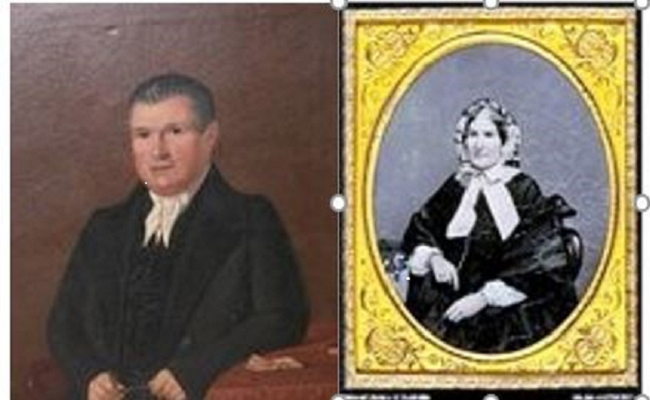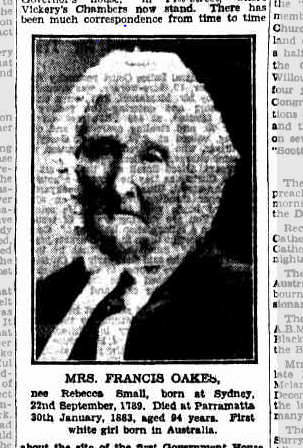
Francis Oakes was born on 15 April 1770 at Foleshill, Warwickshire, England. He was a shoemaker by trade, and he volunteered as an artisan missionary to go to the South Seas in the Duff in 1796. He was stationed at Tahiti. When Rev. James Cover decided to leave the mission, Francis Oakes joined him. After arriving in Australia in 1798, he quickly abandoned his missionary life for other pursuits. He received a grant of 100 acres of land on 16th April 1799 at Dundas known “Langford Farm”. This was part of the group of Land Grants along the "Northern boundary". In 1804, he added on another 50 acres adjoining this property and began farming there. The Sydney Gazette of 15 Jan 1804 reported that a fire had broken out on his farm (at Pennant Hills) and “destroyed a barn containing much produce”.
In September 1805, Francis was appointed chief constable for the Parramatta district. Francis Oakes owned a home in the corner of Church and Phillip Streets in Parramatta.

Sydney Gazette, September 1, 1805
On 27 January 1806 Francis married Rebecca, the daughter of John and Mary Small. Rebecca was the first white girl born in Australia. She was born in Sydney on 22 September 1789 and received some acclaim as 'the first or second Anglo-Australian to be married'. Francis and Rebecca had fourteen children, seven sons and seven daughters:
- Elizabeth (Armstrong) 1806
- Ann (Byrnes) 1808
- Mary (Hutchinson) 1810
- George Oakes 1813
- Rebecca (Richardson and Muriel) 1815
- Susannah Hassall (Sprent) 1816
- Francis Rowland Oakes 1818
- Lucy Oakes 1819 (died aged 9)
- Rowland Hassall Oakes 1821
- Samuel Oakes 1822 (died aged 1)
- James Lawry Oakes 1824
- John Leigh Oakes 1826
- Martha (Tertius West) 1828
- William Henry Oakes 1831
Francis was regarded as 'a most useful officer', he was involved in three of the cases leading to the overthrow of Governor William Bligh. He gave evidence at the official investigation into the conduct of D'Arcy Wentworth, was sent to arrest John Macarthur for refusing to attend an inquiry concerning the schooner Parramatta, and lodged a deposition against Macarthur, who had resisted arrest. His report resulted in the immediate criminal prosecution of Macarthur, who blamed Francis for misconstruing his conversation. During the rebel administration Francis was dismissed from office. He was one of the settlers who petitioned the Colonial Office in alarm at the condition of the colony; he was chosen by Bligh as a witness to attend Lieutenant-Colonel George Johnston's court martial and sailed to England with Bligh in May 1810.
He returned to New South Wales in the Mary in May 1812 and resumed his duties. Besides being a police officer and farmer, he was also an auctioneer, baker, shopkeeper and contractor.
In 1814-22 he was superintendent of the Female Factory at Parramatta. He was an honest steady citizen. Francis died at Parramatta on 5 February 1844. Rebecca Oakes (nee Small) the matriarch of the Oakes family died on 30 January 1883 at the age of 94 in Parramatta.

Two of Francis and Rebecca’s sons, George Oakes (1813-1881) and Francis Rowland Oakes became members of parliament.
Mary (1810-1880), the third daughter, worked among the female convicts. In 1826 she married Rev. John Hutchinson (1792-1866), the first Wesleyan minister to be ordained in Australia. After working briefly as a missionary in Tonga, Hutchinson returned to Sydney in 1828 and in January 1832 he became superintendent of the Female House of Correction in Hobart. Mary was appointed matron and according to Sir William Denison was 'virtually the superintendent'. When John was forced to resign through ill health in March 1851, Mary was made in charge of the Female Factory in Launceston. She was noted for her efficiency and carried out her duties until she retired in August 1854. This was after the cessation of transportation to Tasmania. She died at North Hobart on 19 February 1880.
Francis and Rebecca’s grandson, Archdeacon George Spencer Oakes (1855-1932) was a noted Church of England clergyman in the west of New South Wales.
On 16 April 1931, The Cumberland Argus reports that a ceremony was performed at St. John's, Parramatta by the Archbishop of Sydney, Dr Wright, who unveiled “a handsome marble cruciform tablet, erected by Archdeacon Oakes, of Bathurst and the other descendants, to the memory of Francis and Rebecca Oakes, pioneer missionaries in the town of Parramatta”.
![]()
Neera Sahni, Research Services Leader, Parramatta heritage Centre, City of Parramatta 2021
Reference:
- National Archives of Australia - http://www.naa.gov.au/ retrieved on 26/03/2021
- National Library of Australia Trove Digitised Newspapers Database – Death of Hon George Oakes, MLC retrieved on 26/03/2021
- National Library of Australia Trove Digitised Newspapers Database - Pioneers Missionaries Francis and Rebecca Oakes Memorial Tablet Unveiled retrieved on 26/03/2021
- National Library of Australia Trove Digitised Newspapers Database - Parramatta retrieved on 27/03/2021
- Gunson,N (1967) 'Oakes, Francis (1770–1844)', Australian Dictionary of Biography, National Centre of Biography, Australian National University. http://adb.anu.edu.au/biography/oakes-francis-2513/text3397 retrieved on 30/03/2021
- NSW Environment and Heritage - http://www.environment.nsw.gov.au/Heritage/research/rumtrack.htm retrieved on 26/03/2021
- State Library of NSW - http://www.sl.nsw.gov.au/ retrieved on 31/03/2021
- NSW State Archives and Records. Colonial Secretary’s Papers. Colonial Secretary Index, 1788-1825. Oadham to Oatley and Parramatta, Female Factory. Viewed at https://www.records.nsw.gov.au/node/1696#o retrieved on 26/03/2021


